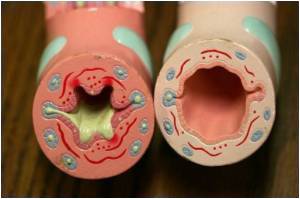Researchers have identified a molecular pathway that leads to increased mucus production and inflammation in patients with asthma.

"In this project, we found out 15 HETE is conjugated to a common phospholipid," she said. "That complex, called 15HETE-PE, and 15LO1 behave as signaling molecules that appear to have a powerful influence on airway inflammation."
By examining lung cells obtained by bronchoscopy from 65 people with asthma, the researchers found that both 15LO1 and 15HETE-PE displace an inhibitory protein called PEBP1 from its bond with another protein called Raf-1, which when freed can lead to activation of extracellular signal-regulated kinase(ERK). Activated ERK is commonly observed in the epithelial, or lung lining, cells in asthma, but until now the reason for that was not understood.
"This is an important study as it directly explores the important role of 15-lipoxygenase 1 in the airway epithelial cells of patients with asthma, which immediately establishes the relevance to human disease," said Mark T. Gladwin, M.D., chief, Division of Pulmonary, Allergy and Critical Care Medicine, UPSOM.
Other experiments showed that knocking down 15LO1 decreased the dissociation of Raf-1 from PEBP1, which in turn reduced ERK activation. The pathway ultimately influences the production of factors involved in inflammation and mucus production.
"These results show us on both a molecular and mechanistic level and as mirrored by fresh cells from the patients themselves that the epithelial cells of people with asthma are very different from those that don't have it," Dr. Wenzel said. "It also gives us a potential treatment strategy: If we can prevent Raf-1 displacement, we might have a way of stopping the downstream consequences that lead to asthma."
Advertisement










